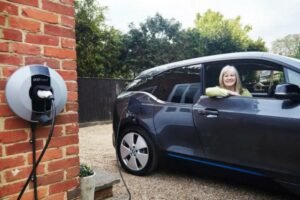Introduction to EV Charging Points
What are EV Car Chargers?
 Electric vehicles, often referred to as Electric Cars, are revolutionising the way we think about transport. Operating on electric batteries rather than traditional internal combustion engines, EVs are at the forefront of reducing carbon emissions and promoting sustainable transportation. To maintain the performance of an electric vehicle, it is crucial to understand how the battery charging process works. This involves plugging the vehicle into an electric car charger to replenish the energy stored in the batteries, much like charging a mobile phone. Knowing the types of EV chargers, how to use them efficiently, and how they integrate into the energy ecosystem is essential for EV owners.
Electric vehicles, often referred to as Electric Cars, are revolutionising the way we think about transport. Operating on electric batteries rather than traditional internal combustion engines, EVs are at the forefront of reducing carbon emissions and promoting sustainable transportation. To maintain the performance of an electric vehicle, it is crucial to understand how the battery charging process works. This involves plugging the vehicle into an electric car charger to replenish the energy stored in the batteries, much like charging a mobile phone. Knowing the types of EV chargers, how to use them efficiently, and how they integrate into the energy ecosystem is essential for EV owners.
Types of EV Chargers
Electric vehicle car chargers come in different types, mainly categorised by the power output and speed of charging. This section will dive into Level 1, Level 2, and DC Fast Chargers, helping you discern their differences and utilities.
Level 1 Chargers
Level 1 chargers are the simplest form of EV car chargers and use a standard 120-volt AC outlet. These chargers usually come with the car and require no special installation, as they can be plugged into a regular household outlet. Because Level 1 chargers typically deliver about 2-5 miles of range per hour of charging, they are best suited for plug-in hybrid electric vehicles with smaller battery sizes or as a backup charging option. For full-battery electric vehicles, Level 1 chargers are more practical for overnight charging or in situations where the vehicle isn’t used heavily.
Level 2 Chargers
A step up from Level 1, Level 2 chargers operate on a 240-volt AC outlet, similar to what a washing machine or oven might use. This type of charger is more efficient and can deliver approximately 10-60 miles of range per hour, depending on the vehicle and charger specifications. Level 2 chargers are versatile, as they can be installed at home or found in public charging stations. Many EV owners opt for installing a Level 2 charger at home for faster daily charging.
DC Fast Chargers
DC Fast Chargers, sometimes referred to as Level 3 chargers, are the ultimate solution for rapid charging. These chargers use a direct current (DC) rather than alternating current (AC) and typically provide 60-80% of the battery charge in just 20-30 minutes. They are especially beneficial for long trips where extended charging times are impractical. However, frequent usage of DC Fast Chargers might have an impact on battery health over time.
Car Charging Times and Factors
Charging times are subject to a variety of factors including the type of charger, the capacity of the vehicle’s battery, the car’s state of charge, and ambient temperature. Level 1 chargers are the slowest and might require up to 24 hours for a full charge for some vehicles, whereas Level 2 chargers can usually accomplish the task within 4-6 hours. DC Fast Chargers, on the other hand, are meant for quick top-ups during long trips rather than full charges.
Additionally, environmental factors like cold weather can slow down the charging process, while extremely hot conditions might cause the battery to heat up, which can be detrimental in the long term.
Home Charging Installation and Costs
 Setting up home charging is a convenient option for EV owners. While Level 1 charging doesn’t require any special installation, a Level 2 charger will necessitate some electrical work. The installation process involves setting up a 240-volt circuit and mounting the charging equipment. It’s important to hire a qualified electrician familiar with EV charging installations.
Setting up home charging is a convenient option for EV owners. While Level 1 charging doesn’t require any special installation, a Level 2 charger will necessitate some electrical work. The installation process involves setting up a 240-volt circuit and mounting the charging equipment. It’s important to hire a qualified electrician familiar with EV charging installations.
Costs can be variable depending on the charger you select, electrical upgrades needed, and local labour rates. On average, costs range from €500 to over €2,000. It is also advisable to check for local incentives or rebates which might offset some of these costs.
Public Charging Stations
Public charging stations are an indispensable asset for EV owners, particularly for those who are on the move or don’t have access to home charging. Public stations generally offer Level 2 or DC Fast Charging. They are strategically located in areas like shopping centres, parking garages, and along highways.
Some stations are free, while others may have a pay-per-use model. The pricing can be based on the amount of energy used or the duration of charging. Various networks, such as ChargePoint, EVgo, and Tesla’s Superchargers, have their own pricing structures and membership options.
Impact on Electricity Bill
Charging an electric vehicle can have a noticeable effect on your electricity bill. To mitigate costs, it is beneficial to be mindful of the electricity rates in your area. Some utilities offer time-of-use plans which feature lower rates during off-peak hours, making overnight charging a cost-effective strategy.
Investing in a Level 2 charger can also be more energy-efficient compared to a Level 1 charger, potentially reducing costs in the long term. Additionally, if your area has renewable energy options, integrating solar panels can offset electricity costs.
Safety and Weather Conditions
Modern electric vehicle chargers are designed with safety features, including ground-fault circuit interrupters (GFCIs) and weatherproof casing. Charging in rain is generally safe, but always make sure to follow the manufacturer’s guidelines.
In extremely cold conditions, batteries may take longer to charge. Some electric vehicles have thermal management systems to heat or cool the battery, ensuring efficient charging regardless of weather conditions.
Smart Chargers
Smart chargers bring connectivity and convenience to electric vehicle charging. These chargers connect to the internet, allowing you to remotely monitor and control the charging process through a smartphone app. Features include scheduling, notifications, and energy usage statistics. Furthermore, smart chargers can integrate with home energy management systems to optimise charging based on electricity rates and household consumption.
Vehicle-to-Grid (V2G) Technology
Vehicle-to-grid (V2G) technology represents an innovative way electric vehicles can interact with the electrical grid. Through V2G, not only can an electric vehicle draw power from the grid, but it can also send energy back. This bi-directional energy transfer can help stabilise the grid during peak demand and potentially allow EV owners to earn money or credits by supplying energy back to the grid.
Choosing the Right Charger
When selecting an EV charger, consider your vehicle’s specifications, daily driving range, and electrical infrastructure. Level 2 chargers are a popular choice for their efficiency and versatility. However, if your driving patterns involve frequent long distances, accessibility to DC Fast Chargers is also an important consideration. Additionally, a smart charger can be an investment that pays off in convenience and energy management.
The Benefits of Installing an EV Car Charger
Installing an EV car charger at home or a business establishment comes with a host of benefits. Let’s break down these advantages for both home and business settings:
Car Chargers For The Home:
Installing an EV Car Charger at Home
Convenience: Having an EV charger at home is highly convenient. You can simply plug in your vehicle when you get home and have it fully charged and ready to go by the morning. There is no need to make extra stops at public charging stations.
Time-Saving: With a home charger, especially a Level 2 charger, you save time as the charging process is faster than using a standard outlet. You can also choose when to charge, such as during off-peak hours to save on electricity costs.
Cost-Effective: Home charging is usually cheaper than charging at public stations, particularly if you have a time-of-use electricity rate plan. Over time, this can result in significant savings.
Increased Property Value: Installing an EV charger can increase the value of your property, as it becomes an attractive feature for potential buyers who own or are considering owning an electric vehicle.
Integration with Renewable Energy: If your home is equipped with solar panels or other renewable energy sources, you can charge your vehicle using green energy, further reducing your carbon footprint.
Car Chargers For The Business:
Installing EV Car Chargers at Your Business
Attract Customers: Businesses with EV charging stations can attract customers who own electric vehicles. While charging their car, they are likely to patronise the business.
Enhance Brand Image: Offering EV charging stations positions a business as environmentally responsible and sustainability-focused, which can enhance brand image and reputation.
Employee Benefits: For businesses, installing EV chargers can serve as an added benefit for employees who own electric vehicles, contributing to employee satisfaction and potentially serving as a recruitment tool.
Tax Incentives and Rebates: Businesses may qualify for local, state, or federal incentives and rebates for installing EV chargers, which can help offset the installation costs.
Potential Revenue Stream: Businesses can opt to charge a fee for the use of their EV charging stations, creating an additional revenue stream.
Corporate Sustainability Goals: Incorporating EV chargers aligns with corporate sustainability goals and can contribute to achieving certifications such as LEED.
Networking and Partnerships: By installing EV chargers, businesses may also have the opportunity to participate in broader networks of charging stations, further increasing visibility and potential partnerships.
Whether for home or business, installing an EV car charger brings a multitude of benefits ranging from convenience and cost savings to sustainability and enhanced brand image. It’s a forward-looking investment that supports the transition to cleaner transportation options.
Power Your Electric Vehicle with the Sun
Welcome to the future of sustainable driving! Combining electric vehicles with solar power is an exceptional way to reduce your carbon footprint and save money. At [Your Company Name], we’re passionate about clean energy and are excited to offer innovative solutions for powering your electric vehicle (EV) car chargers with solar panel systems and solar carports.
Solar-Powered Car Charging: A Perfect Synergy
As an electric vehicle owner, you’re already contributing to a greener planet. Take your eco-friendliness to the next level by pairing your EV with solar power. By harnessing the sun’s energy to charge your car, you can eliminate the need for fossil fuels entirely for your travel needs.
Why Solar?
Cost Savings: Though there is an initial investment, solar panels significantly reduce your electricity bills. With enough panels, your EV charging could be entirely offset by the energy your system generates.
Sustainability: Solar power is clean and renewable. By using solar energy to charge your electric vehicle, you’re actively reducing your carbon footprint and promoting sustainability.
Energy Independence: A solar panel system can reduce or even eliminate your dependence on the grid. This is especially valuable during power outages or periods of high electricity demand.
Incentives: Governments often provide tax incentives, rebates, or grants for installing solar systems. This can significantly reduce the cost of your investment.
Introducing Solar Carports
Solar carports are an innovative way to integrate solar power into your electric vehicle charging. Essentially, they are carports with solar panels mounted on the roof. This not only generates clean energy but also provides shade for your vehicle.
Benefits of Solar Carports
Space-Efficient: Solar carports are especially beneficial if roof space is limited or not optimal for solar panels.
Multi-purpose: They serve a dual purpose by generating electricity and providing covered parking.
Scalability: Solar carports can be designed to accommodate a single vehicle or an entire fleet, making them versatile for both residential and commercial applications.
Frequently Asked Questions About Car Chargers
What are the different types of EV chargers?
There are three main types of EV chargers – Level 1, Level 2, and DC Fast Chargers. Level 1 chargers use a standard 120-volt AC outlet, much like a household plug, and are the slowest, typically offering about 2 to 5 miles of range per hour of charging. Level 2 chargers require a 240-volt AC circuit (similar to a clothes dryer or oven) and can deliver 10-60 miles of range per hour, making them suitable for home and public charging. DC Fast Chargers are the fastest option and operate at higher voltages, often above 400 volts DC. They can typically provide 60-80% of the battery’s charge in 20-30 minutes, making them ideal for highway rest stops and fuel stations.
How long does it take to charge an electric vehicle?
The duration of charging an electric vehicle varies widely based on several factors such as the type of charger used, the battery’s capacity, how depleted the battery is, and the vehicle’s charging rate. Level 1 chargers are the slowest and can take up to 24 hours to fully charge a large battery. Level 2 chargers are faster and can typically fully charge a vehicle in 4 to 8 hours. DC Fast Chargers can charge a battery to about 80% in approximately 20-30 minutes but are not typically used for charging to 100% due to the stress on the battery during high-speed charging.
What is the difference between Level 1, Level 2, and DC fast charging?
Level 1 chargers use standard household 120-volt outlets and are the slowest method, typically used for plug-in hybrids or as a backup option. Level 2 chargers use a 240-volt circuit and are ideal for all-electric cars and long-range plug-in hybrids, offering a significantly faster charge compared to Level 1. DC Fast Chargers are the quickest method, utilising direct current (DC) to bypass the car’s onboard charger, resulting in a rapid charge. They are mainly used in public charging stations for long-distance travel.
Can I install an EV charger at home? What are the requirements?
Yes, you can install an EV charger at home. For Level 1 charging, you just need a standard electrical outlet. For Level 2 charging, you need a 240-volt circuit, which might require an electrician to install. It’s important to ensure your home’s electrical system can handle the added load. You will also need a suitable place to mount the charger and enough space to park your vehicle within reach of the charging cable.
How much does it cost to install an EV charger at home?
The cost of installing an EV charger at home varies depending on the type of charger, the complexity of the installation, and local labour rates. A Level 2 charger typically costs between €500 and €700, and the installation can range from €300 to €1,000 or more. In total, expect to spend somewhere between €800 to €1,700 or more.
Are public charging stations available? How do I find them?
Yes, public charging stations are increasingly common. They can be found at shopping centres, public parking areas, hotels, and along highways. To locate them, you can use various smartphone apps and websites such as PlugShare, ChargePoint, or the charging station locator on the U.S. Department of Energy’s website.
How much does it cost to charge an electric vehicle at a public charging station?
The cost to charge at a public station varies. Some are free, while others charge by the kilowatt-hour or by the minute. On average, the cost ranges from €0.15 to €0.60 per kilowatt-hour. DC Fast Chargers tend to be more expensive than Level 2 Chargers.
Are there any incentives or rebates available for installing an EV charger?
There are various federal, state, and local incentives available for installing an EV charger. The U.S. federal government offers a tax credit covering 30% of the cost of an EV charger and installation. Many states and utilities offer additional rebates and incentives.
Is it safe to charge an electric vehicle in the rain?
Yes, it is safe to charge an electric vehicle in the rain. EV chargers are designed to be weather-resistant and have safety features such as ground-fault circuit interrupters (GFCIs) to prevent electric shocks.
What is the impact of temperature on EV charging?
Extreme temperatures can affect EV charging. Cold weather can slow down the charging process and reduce the battery’s range. Hot weather can also impact battery performance. Some EVs have thermal management systems to mitigate these effects.
Can charging cables and connectors be used universally among different EV brands?
There are different types of charging connectors, but many are standardised. In the U.S., the J1772 connector is standard for Level 1 and Level 2 AC charging. Most EVs come with this, except Tesla, which has its proprietary connector. However, Tesla provides an adapter. For DC Fast Charging, there are different standards – CHAdeMO, CCS, and Tesla’s Supercharger network.
How does charging an electric vehicle affect my electricity bill?
Charging an EV will increase your electricity bill, but the exact amount depends on your local electricity rates and how often you charge. Charging at night during off-peak hours can be more cost-effective.
What are smart chargers and how do they differ from standard chargers?
Smart chargers are connected to the internet and allow for advanced features such as remote monitoring, scheduling, energy usage tracking, and integration with home energy systems. Standard chargers are more basic and simply provide a charge without advanced features.
How do I choose the right EV charger for my vehicle and needs?
When choosing an EV charger, consider your daily driving distance, vehicle specifications, electrical capacity at your home, and budget. Level 2 chargers are suitable for most users. If you frequently take long trips, ensure you have access to DC Fast Charging stations along your route.
What is vehicle-to-grid (V2G) technology and how can it be used with EV chargers?
Vehicle-to-grid (V2G) technology allows electric vehicles to not only draw power from the grid but also send it back. This can be used to help stabilise the grid during peak times, and in some cases, owners can be compensated for the electricity they provide back to the grid. This requires compatible EV chargers and vehicles, as well as participation in a V2G program.
15 Ways To Reduce Fuel Consumption to Become Greener
Saving fuel in a car with a combustion engine is beneficial for both your wallet and the environment. Here are some tips to help you achieve better fuel efficiency:
Drive Smoothly: Aggressive driving with rapid acceleration and hard braking consumes more fuel. Drive smoothly and anticipate traffic flow to reduce unnecessary acceleration and braking.
Maintain Optimal Speed: Fuel efficiency typically decreases at speeds above 55-60 mph (88-96 kph). When on highways, try to maintain an optimal speed and use cruise control to keep a steady pace.
Reduce Idling: Idling consumes fuel. If you’re stopped for more than a minute or two, it’s usually more fuel-efficient to turn off the engine and restart it when you’re ready to move.
Properly Inflate Tires: Under-inflated tires create more rolling resistance and reduce fuel efficiency. Check your tire pressure regularly and keep them inflated to the manufacturer’s recommended levels.
Use Air Conditioning Wisely: Air conditioning can increase fuel consumption. At low speeds, it may be more efficient to open the windows, but at higher speeds, the drag from open windows can consume more fuel than using air conditioning.
Reduce Weight: The more weight your car carries, the more fuel it uses. Remove unnecessary items from your car, especially heavy ones.
Maintain Your Car: Regular maintenance is crucial. Replace air filters, change the oil, and ensure your engine is tuned properly. A well-maintained engine runs more efficiently.
Use the Right Gear: If driving a manual, shift up early and down late to stay in a lower RPM range. If driving an automatic, ensure the transmission is shifting smoothly.
Plan Routes: Plan your routes and combine trips to reduce the distance you drive. Avoiding heavy traffic and opting for routes with less stop-and-go traffic can save fuel.
Use the Correct Fuel Grade: Use the grade of fuel recommended by your car’s manufacturer. Higher octane fuel doesn’t necessarily mean better fuel efficiency for cars not designed for it.
Limit the Use of Roof Racks and Remove Unused Attachments: Roof racks, especially when loaded, increase aerodynamic drag and lower fuel efficiency. Remove them when not in use.
Drive Less: Whenever possible, consider alternatives to driving, such as walking, biking, carpooling, or using public transportation. This not only saves fuel but also reduces wear on your vehicle.
Anticipate Traffic Lights: When approaching a red light, let off the gas early and coast to a stop. This uses less fuel than driving up to the light and braking hard.
Avoid Excessive Engine Warm-up: Modern engines don’t require extensive warm-up times, even in cold weather. More than a minute of idling is usually unnecessary.
Use Eco Mode If Available: Some cars have an Eco mode that adjusts various systems like throttle response and air conditioning to save fuel.
Implementing these tips can help you significantly reduce your fuel consumption and minimise the environmental impact of driving a car with a combustion engine.
Experience the Future of Sustainable Energy with Solares Energies
At Solares Energies, we are dedicated to powering your sustainable future. As a trusted provider of EV car chargers, solar panel systems, and solar carports, we offer comprehensive solutions to meet your clean energy needs. With our expertise and commitment to quality, you can embrace a greener lifestyle while enjoying the benefits of cost savings and energy independence.
Our Renewable Solutions
EV Car Chargers
Charge your electric vehicle conveniently and efficiently with our cutting-edge EV car chargers. We provide a range of charging solutions tailored to your specific requirements, ensuring that you can power up your EV with ease and confidence. Our team of experts will guide you through the selection process, installation, and ongoing maintenance to ensure a seamless experience.
Solar Panel Systems
Harness the power of the sun with our high-performance solar panel systems. Our solar solutions are designed to maximize energy generation, reduce your reliance on the grid, and save you money on electricity bills. From initial consultation to installation and beyond, we are committed to delivering exceptional service and top-quality solar systems for your home or business.
Solar Carports
Combine the benefits of solar energy and covered parking with our innovative solar carports. Our custom-designed carports not only provide shade for your vehicles but also generate clean, renewable energy. With Solares Energies, you can maximize the use of space while reducing your environmental impact. Our team will work closely with you to create a solar carport solution that meets your unique needs.
Contact Solares Energies Today!
Discover the advantages of sustainable energy solutions with Solares Energies. Our team of experts is ready to assist you in taking the next step towards a greener future. Visit our website at solaresenergies.com to explore our services and learn more about how we can meet your clean energy needs.
To get in touch, please email us at contactus@solaresenergies.com. We look forward to hearing from you and helping you make a positive impact on the environment while enjoying the benefits of clean, renewable energy.



 Solar Panel Products & Articles
Solar Panel Products & Articles Other Products & Services
Other Products & Services



